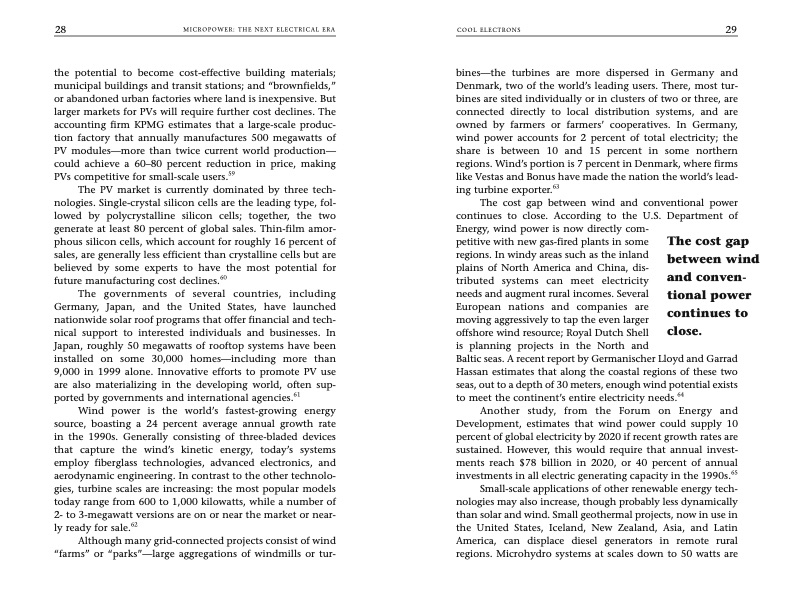
PDF Publication Title:
Text from PDF Page: 015
28 MICROPOWER: THE NEXT ELECTRICAL ERA COOL ELECTRONS 29 the potential to become cost-effective building materials; municipal buildings and transit stations; and “brownfields,” or abandoned urban factories where land is inexpensive. But larger markets for PVs will require further cost declines. The accounting firm KPMG estimates that a large-scale produc- tion factory that annually manufactures 500 megawatts of PV modules—more than twice current world production— could achieve a 60–80 percent reduction in price, making PVs competitive for small-scale users.59 The PV market is currently dominated by three tech- nologies. Single-crystal silicon cells are the leading type, fol- lowed by polycrystalline silicon cells; together, the two generate at least 80 percent of global sales. Thin-film amor- phous silicon cells, which account for roughly 16 percent of sales, are generally less efficient than crystalline cells but are believed by some experts to have the most potential for future manufacturing cost declines.60 The governments of several countries, including Germany, Japan, and the United States, have launched nationwide solar roof programs that offer financial and tech- nical support to interested individuals and businesses. In Japan, roughly 50 megawatts of rooftop systems have been installed on some 30,000 homes—including more than 9,000 in 1999 alone. Innovative efforts to promote PV use are also materializing in the developing world, often sup- ported by governments and international agencies.61 Wind power is the world’s fastest-growing energy source, boasting a 24 percent average annual growth rate in the 1990s. Generally consisting of three-bladed devices that capture the wind’s kinetic energy, today’s systems employ fiberglass technologies, advanced electronics, and aerodynamic engineering. In contrast to the other technolo- gies, turbine scales are increasing: the most popular models today range from 600 to 1,000 kilowatts, while a number of 2- to 3-megawatt versions are on or near the market or near- ly ready for sale.62 Although many grid-connected projects consist of wind “farms” or “parks”—large aggregations of windmills or tur- bines—the turbines are more dispersed in Germany and Denmark, two of the world’s leading users. There, most tur- bines are sited individually or in clusters of two or three, are connected directly to local distribution systems, and are owned by farmers or farmers’ cooperatives. In Germany, wind power accounts for 2 percent of total electricity; the share is between 10 and 15 percent in some northern regions. Wind’s portion is 7 percent in Denmark, where firms like Vestas and Bonus have made the nation the world’s lead- ing turbine exporter.63 The cost gap between wind and conventional power continues to close. According to the U.S. Department of Energy, wind power is now directly com- petitive with new gas-fired plants in some regions. In windy areas such as the inland plains of North America and China, dis- tributed systems can meet electricity needs and augment rural incomes. Several European nations and companies are moving aggressively to tap the even larger offshore wind resource; Royal Dutch Shell is planning projects in the North and Baltic seas. A recent report by Germanischer Lloyd and Garrad Hassan estimates that along the coastal regions of these two seas, out to a depth of 30 meters, enough wind potential exists to meet the continent’s entire electricity needs.64 Another study, from the Forum on Energy and Development, estimates that wind power could supply 10 percent of global electricity by 2020 if recent growth rates are sustained. However, this would require that annual invest- ments reach $78 billion in 2020, or 40 percent of annual investments in all electric generating capacity in the 1990s.65 Small-scale applications of other renewable energy tech- nologies may also increase, though probably less dynamically than solar and wind. Small geothermal projects, now in use in the United States, Iceland, New Zealand, Asia, and Latin America, can displace diesel generators in remote rural regions. Microhydro systems at scales down to 50 watts are The cost gap between wind and conven- tional power continues to close.PDF Image | Micropower: The Next Electrical Era

PDF Search Title:
Micropower: The Next Electrical EraOriginal File Name Searched:
EWP151.pdfDIY PDF Search: Google It | Yahoo | Bing
Capstone Turbine and Microturbine: Capstone microturbines used and new surplus for sale listing More Info
Consulting and Strategy Services: Need help with Capstone Turbine, sizing systems, applications, or renewable energy strategy, we are here to assist More Info
Container Lumber Dry Kiln: Since 1991 developing and innovating dry kilns using standard shipping containers More Info
Supercritical CO2 Lumber Dry Kiln: Compact fast drying in 3 days or less for small amounts of wood and lumber drying More Info
BitCoin Mining: Bitcoin Mining and Cryptocurrency... More Info
Publications: Capstone Turbine publications for microturbine and distributed energy More Info
FileMaker Software for Renewable Energy Developing database software for the renewable energy industry More Info
CO2 Gas to Liquids On-Demand Production Cart Developing a supercritical CO2 to alcohol on-demand production system (via Nafion reverse fuel cell) More Info
Stranded Gas for low cost power Bitcoin Mining Using stranded gas for generators may provide breakthrough low power costs for cryptocurrency miners. More Info
| CONTACT TEL: 608-238-6001 Email: greg@globalmicroturbine.com | RSS | AMP |